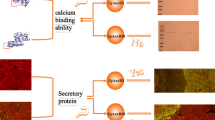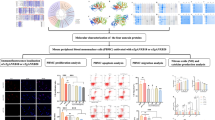Abstract
Smad family proteins are essential cellular mediators of the transforming growth factor-β superfamily. In the present study, we identified two members of the Smad proteins, Smad8 and Smad4 homologues (termed as EgSmadE and EgSmadD, respectively), from Echinococcus granulosus, the causative agent of cystic echinococcosis (CE). Phylogenetic analysis placed EgSmadE in the Smad1, 5, and 8 subgroup of the R-Smad sub-family and EgSmadD in the Co-Smad family. Furthermore, EgSmadE and EgSmadD attained a high homology to EmSmadE and EmSmadD of E. multilocularis, respectively. Both EgSmadE and EgSmadD were co-expressed in the larval stages and exhibited the highest transcript levels in activated protoscoleces, and their encoded proteins were co-localized in the sub-tegumental and tegumental layer of the parasite. As shown by yeast two-hybrid and pull-down analysis, EgSmadE displayed a positive binding interaction with EgSmadD. In addition, EgSmadE localized in the nuclei of Mv1Lu cells (mink lung epithelial cells) upon treatment with human TGF-β1 or human BMP2, indicating that EgSmadE is capable of being translocated into nucleus, in vitro. Our study suggests that EgSmadE and EgSmadD may take part in critical biological processes, including echinococcal growth, development, and parasite-host interaction.







Similar content being viewed by others
References
Beall MJ, Pearce EJ (2002) Transforming growth factor-beta and insulin-like signalling pathways in parasitic helminths. Int J Parasitol 32(4):399–404
Beall M, McGonigle S, Pearce E (2000) Functional conservation of Schistosoma mansoni Smads in TGF-beta signaling. Mol Biochem Parasitol 111(1):131–142
Brehm K (2010a) Echinococcus multilocularis as an experimental model in stem cell research and molecular host-parasite interaction. Parasitology 137(3):537–555
Brehm K (2010b) The role of evolutionarily conserved signalling systems in Echinococcus multilocularis development and host-parasite interaction. Med Microbiol Immunol 199(3):247–259
Brehm K, Spiliotis M (2008) The influence of host hormones and cytokines on Echinococcus multilocularis signalling and development. Parasite 15(3):286–290
Brehm K, Wolf M, Beland H, Kroner A, Frosch M (2003) Analysis of differential gene expression in Echinococcus multilocularis larval stages by means of spliced leader differential display. Int J Parasitol 33(11):1145–1159
Calonge MJ, Massague J (1999) Smad4/DPC4 silencing and hyperactive ras jointly disrupt transforming growth factor-beta antiproliferative responses in colon cancer cells. J Biol Chem 274(47):33637–33643
Camicia F, Paredes R, Chalar C, Galanti N, Kamenetzky L, Gutierrez A, Rosenzvit MC (2008) Sequencing, bioinformatic characterization and expression pattern of a putative amino acid transporter from the parasitic cestode Echinococcus granulosus. Gene 411:1–9
Carlo J, Osman A, Niles EG, Wu W, Fantappie MR, Oliveira FM, LoVerde PT (2007) Identification and characterization of an R-Smad ortholog (SmSmad1B) from Schistosoma mansoni. FEBS J 274(16):4075–4093
de Caestecker MP, Yahata T, Wang D, Parks WT, Huang S, Hill CS, Shioda T, Roberts AB, Lechleider RJ (2000) The Smad4 activation domain (SAD) is a proline-rich, p300-dependent transcriptional activation domain. J Biol Chem 275(3):2115–2122
Ebisawa T, Fukuchi M, Murakami G, Chiba T, Tanaka K, Imamura T, Miyazono K (2001) Smurf1 interacts with transforming growth factor-beta type I receptor through Smad7 and induces receptor degradation. J Biol Chem 276(16):12477–12480
Epping K, Brehm K (2011) Echinococcus multilocularis: molecular characterization of EmSmadE, a novel BR-Smad involved in TGF-β and BMP signaling. Exp Parasitol 129(2):85–94
Freitas TC, Jung E, Pearce EJ (2007) TGF-beta signaling controls embryo development in the parasitic flatworm Schistosoma mansoni. PLoS Pathog 3(4):e52
Funaba M, Mathews LS (2000) Identification and characterization of constitutively active Smad2 mutants: evaluation of formation of Smad complex and subcellular distribution. Mol Endocrinol 14(10):1583–1591
Gelmedin V, Caballero-Gamiz R, Brehm K (2008) Characterization and inhibition of a p38-like mitogen-activated protein kinase (MAPK) from Echinococcus multilocularis: antiparasitic activities of p38 MAPK inhibitors. Biochem Pharmacol 76(9):1068–1081
Gemma A, Hagiwara K, Vincent F, Ke Y, Hancock AR, Nagashima M, Bennett WP, Harris CC (1998) hSmad5 gene, a human hSmad family member: its full length cDNA, genomic structure, promoter region and mutation analysis in human tumors. Oncogene 16(7):951–956
Hemer S, Konrad C, Spiliotis M, Koziol U, Schaack D, Förster S, Gelmedin V, Stadelmann B, Dandekar T, Hemphill A, Brehm K (2014) Host insulin stimulates Echinococcus multilocularis insulin signalling pathways and larval development. BMC Biol 12:5. doi:10.1186/1741-7007-12-5
Huang S, Flanders KC, Roberts AB (2000) Characterization of the mouse Smad1 gene and its expression pattern in adult mouse tissues. Gene 258(1–2):43–53
Huse M, Muir TW, Xu L, Chen YG, Kuriyan J, Massague J (2001) The TGF beta receptor activation process: an inhibitor- to substrate-binding switch. Mol Cell 8(3):671–682
Jeong W, Park O, Suh YG, Byun JS, Park SY, Choi E, Kim JK, Ko H, Wang H, Miller AM, Gao B (2011) Suppression of innate immunity (natural killer cell/interferon-γ) in the advanced stages of liver fibrosis in mice. Hepatology 53(4):1342–1351
Kawai S, Faucheu C, Gallea S, Spinella-Jaegle S, Atfi A, Baron R, Roman SR (2000) Mouse smad8 phosphorylation downstream of BMP receptors ALK-2, ALK-3, and ALK-6 induces its association with Smad4 and transcriptional activity. Biochem Biophys Res Commun 271(3):682–687
Kern P (2003) Echinococcus granulosus infection: clinical presentation, medical treatment and outcome. Langenbecks Arch Surg 388(6):413–420
Konrad C, Kroner A, Spiliotis M, Zavala-Gongora R, Brehm K (2003) Identification and molecular characterisation of a gene encoding a member of the insulin receptor family in Echinococcus multilocularis. Int J Parasitol 33(3):301–312
Kretzschmar M, Liu F, Hata A, Doody J, Massague J (1997) The TGF-beta family mediator Smad1 is phosphorylated directly and activated functionally by the BMP receptor kinase. Genes Dev 11(8):984–995
Kretzschmar M, Doody J, Timokhina I, Massague J (1999) A mechanism of repression of TGFbeta/Smad signaling by oncogenic Ras. Genes Dev 13(7):804–816
Li J, Zhang CS, Lü GD, Wang JH, Wen H, Yan GQ, Wei XF, Lin RY (2011) Molecular characterization of a signal-regulated kinase homolog from Echinococcus granulosus. Chin Med J (Engl) 124(18):2838–2844
Macias-Silva M, Abdollah S, Hoodless P, Pirone R, Attisano L, Wrana J (1996) MADR2 is a substrate of the TGFbeta receptor and its phosphorylation is required for nuclear accumulation and signaling. Cell 87(7):1215–1224
Massague J, Wotton D (2000) Transcriptional control by the TGF-beta/Smad signaling system. EMBO J 19(8):1745–1754
Moustakas A, Souchelnytskyi S, Heldin C-H (2001) Smad regulation in TGF-beta signal transduction. J Cell Sci 114(24):4359–4369
Nakao A, Imamura T, Souchelnytskyi S, Kawabata M, Ishisaki A, Oeda E, Tamaki K, Hanai J, Heldin CH, Miyazono K, ten Dijke P (1997) TGF-beta receptor-mediated signalling through Smad2, Smad3 and Smad4. EMBO J 16(17):5353–5362
Osman A, Niles EG, LoVerde PT (2001) Identification and characterization of a Smad2 homologue from Schistosoma mansoni, a transforming growth factor-beta signal transducer. J Biol Chem 276(13):10072–10082
Osman A, Niles EG, LoVerde PT (2004) Expression of functional Schistosoma mansoni Smad4: role in Erk-mediated transforming growth factor beta (TGF-beta) down-regulation. J Biol Chem 279(8):6474–6486
Osman A, Niles EG, Verjovski-Almeida S, LoVerde PT (2006) Schistosoma mansoni TGF-beta receptor II: role in host ligand-induced regulation of a schistosome target gene. PLoS Pathog 2(6):e54
Qin B, Lam SS, Lin K (1999) Crystal structure of a transcriptionally active Smad4 fragment. Structure 7(12):1493–1503
Raftery LA, Sutherland DJ (1999) TGF-beta family signal transduction in Drosophila development: from Mad to Smads. Dev Biol 210(2):251–268
Rezaei H, Kamato D, Ansari G, Osman N, Little P (2012) Cell biology of Smad2/3 linker region phosphorylation in vascular smooth muscle. Clin Exp Pharmacol Physiol 39(8):661–667
Saitou N, Nei M (1987) The neighbor-joining method: a new method for reconstructing phylogenetic trees. Mol Biol Evol 4(4):406–425
Savage-Dunn C (2001) Targets of TGF beta-related signaling in Caenorhabditis elegans. Cytokine Growth Factor Rev 12(4):305–312
Shachar I, Karin N (2013) The dual roles of inflammatory cytokines and chemokines in the regulation of autoimmune diseases and their clinical implications. J Leukoc Biol 93(1):51–61
Sharma V, Antonacopoulou AG, Tanaka S, Panoutsopoulos AA, Bravou V, Kalofonos HP, Episkopou V (2011) Enhancement of TGF-β signaling responses by the E3 ubiquitin ligase arkadia provides tumor suppression in colorectal cancer. Cancer Res 71(20):6438–6449
Shi Y, Wang YF, Jayaraman L, Yang H, Massague J, Pavletich NP (1998) Crystal structure of a Smad MH1 domain bound to DNA: insights on DNA binding in TGF-beta signaling. Cell 94(5):585–594
Spiliotis M, Kroner A, Brehm K (2003) Identification, molecular characterization and expression of the gene encoding the epidermal growth factor receptor orthologue from the fox-tapeworm Echinococcus multilocularis. Gene 323:57–65
Spiliotis M, Konrad C, Gelmedin V, Tappe D, Brückner S, Mösch HU, Brehm K (2006) Characterisation of EmMPK1, an ERK-like MAP kinase from Echinococcus multilocularis which is activated in response to human epidermal growth factor. Int J Parasitol 36(10–11):1097–1112
Tamura K, Peterson D, Peterson N, Stecher G, Nei M, Kumar S (2011) MEGA5: molecular evolutionary genetics analysis using maximum likelihood, evolutionary distance, and maximum parsimony methods. Mol Biol Evol 28(10):2731–2739
Tsai IJ, Zarowiecki M, Holroyd N, Garciarrubio A, Sanchez-Flores A, Brooks KL, Tracey A, Bobes RJ, Fragoso G, Sciutto E, Aslett M, Beasley H, Bennett HM, Cai J, Camicia F, Clark R, Cucher M, De Silva N, Day TA, Deplazes P, Estrada K, Fernández C, Holland PW, Hou J, Hu S, Huckvale T, Hung SS, Kamenetzky L, Keane JA, Kiss F, Koziol U, Lambert O, Liu K, Luo X, Luo Y, Macchiaroli N, Nichol S, Paps J, Parkinson J, Pouchkina-Stantcheva N, Riddiford N, Rosenzvit M, Salinas G, Wasmuth JD, Zamanian M, Zheng Y, Taenia solium Genome Consortium, Cai X, Soberón X, Olson PD, Laclette JP, Brehm K, Berriman M (2013) The genomes of four tapeworm species reveal adaptations to parasitism. Nature 496(7443):57–63
Vuitton DA, Gottstein B (2010) Echinococcus multilocularis and its intermediate host: a model of parasite-host interplay. J Biomed Biotechnol 2010:923–193
Watanabe T, Suzuki M, Omori Y, Hishigaki H, Horie M, Kanemoto N, Fujiwara T, Nakamura Y, Takahashi E (1997) Cloning and characterization of a novel member of the human Mad gene family (MADH6). Genomics 42(3):446–451
Zavala-Gongora R, Kroner A, Wittek B, Knaus P, Brehm K (2003) Identification and characterisation of two distinct Smad proteins from the fox-tapeworm Echinococcus multilocularis. Int J Parasitol 33(14):1665–1677
Zavala-Gongora R, Kroner A, Bernthaler P, Knaus P, Brehm K (2006) A member of the transforming growth factor-beta receptor family from Echinococcus multilocularis is activated by human bone morphogenetic protein 2. Mol Biochem Parasitol 146(2):265–271
Zavala-Gongora R, Derrer B, Gelmedin V, Knaus P, Brehm K (2008) Molecular characterisation of a second structurally unusual AR-Smad without an MH1 domain and a Smad4 orthologue from Echinococcus multilocularis. Int J Parasitol 38(2):161–176
Zhang Y, Feng X, We R, Derynck R (1996) Receptor-associated Mad homologues synergize as effectors of the TGF-beta response. Nature 383(6596):168–172
Zhang WB, Jones MK, Li J, McManus DP (2005) Echinococcus granulosus: pre-culture of protoscoleces in vitro significantly increases development and viability of secondary hydatid cysts in mice. Exp Parasitol 110(1):88–90
Zheng H, Zhang W, Zhang L, Zhang Z, Li J, Lu G, Zhu Y, Wang Y, Huang Y, Liu J, Kang H, Chen J, Wang L, Chen A, Yu S, Gao Z, Jin L, Gu W, Wang Z, Zhao L, Shi B, Wen H, Lin R, Jones MK, Brejova B, Vinar T, Zhao G, McManus DP, Chen Z, Zhou Y, Wang S (2013) The genome of the hydatid tapeworm Echinococcus granulosus. Nat Genet 45(10):1168–1175
Acknowledgments
This work was supported by NSFC Grant Projects (81260252, 81101271, 81260452, 30960342), the Program for Changjiang Scholars and Innovative Research Team in Universities (IRT1181). We would like to thank Liang Li, Hui Liu, Hanhua Hu, Fenglian Xie, and Jianan Tang for their excellent technical assistance.
Ethic and statement
All animal procedures were approved by the Animal Care and Use Committee and the Ethical Committee of The First Affiliated Hospital of Xinjiang Medical University (IACUC-20130514008).
Conflict of interest
The authors declare that they all read and approved the final version of the manuscript sent for publication to Parasitology Research and that they have no conflict of interest that could influence the conclusions of this paper.
Author information
Authors and Affiliations
Corresponding authors
Electronic supplementary material
Below is the link to the electronic supplementary material.
ESM 1
(DOC 101 kb)
Rights and permissions
About this article
Cite this article
Zhang, C., Wang, L., Wang, H. et al. Identification and characterization of functional Smad8 and Smad4 homologues from Echinococcus granulosus . Parasitol Res 113, 3745–3757 (2014). https://doi.org/10.1007/s00436-014-4040-4
Received:
Accepted:
Published:
Issue Date:
DOI: https://doi.org/10.1007/s00436-014-4040-4




